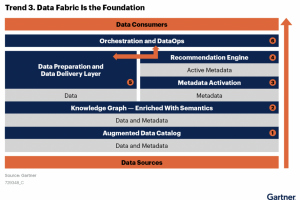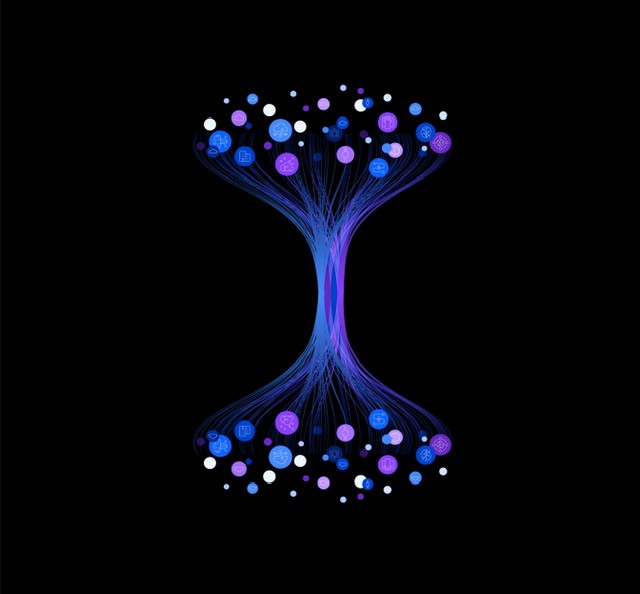We live in a connected world. By 2025, Statista predicts there will be 30.9 billion devices compared to the mere 13.9 billion we use today. How will corporate environments manage all that data? How well are we managing the problem right now?
As more data is generated and the applications for data expand, business requirements and external factors, such as governance, demand new approaches to address growing complexity. For years, businesses of all sizes and types have battled data silos that seem to pop up without warning across an enterprise. For example, the sales department might use a CRM platform, the customer success team spreadsheets and the billing department an accounting system. There is little or no “cross-talk” among these data silos, giving rise to the elusive challenge of unifying systems, data, and external factors so they support – and drive – business objectives.
Data fabric is one solution to the deluge of data and devices both confounding and tooling leaders today.
What is Data Fabric?
A data fabric is an architecture that integrates data and links processes no matter where the data lives. In part, a data fabric is based on grid computing concepts where expanding and evolving considerations are addressed with additional layers in planning and data architecture. It actually connects data from different sources across a distributed landscape – without requiring migration from the data store of origin such as on-premise databases, SaaS applications or cloud-based platforms so that the data is always up-to-date. This is a key differential to data warehousing or data lakes where data is moved to a central location.
Today’s businesses require technology that revolves around agility and security, productivity and actionable insights to enable digital transformation at scale. Data fabric is the emerging data architecture that empowers a more scalable data evolution, transforming data into a reliable business asset while supporting compliance.
IBM, for example, has incorporated a data fabric into the next generation of the IBM Cloud Pak for Data, its unified data is an AI platform that simplifies how enterprises access and use data to accelerate insights.
Can We Trust Our Data?
As business leaders and units seek to develop insights using data analytics, they need to be able to trust their underlying data and systems. Is the data complete? Are the systems unified? Are all the hardware and software systems speaking the same language? What if they aren’t?
Technology leaders understand the importance of protecting data and ensuring it is secure, but currently, it takes a lot of effort, IT resources, and data tracking. Data quality checks are a routine part of confirming the accuracy and purity of data. Data is only as trustworthy as the systems used to generate, organize and classify it. If the data is not accurate, it can lead to severe issues within an organization.
- Data fabric includes an abstraction layer that provides a common business understanding of the data, insights derived from the data, and the automation to act on those insights.
- An AI-enhanced architecture enables self-service data consumption and effective, efficient utilization of resources.
- Data governance then becomes more traceable and manageable. By using a data fabric model, security is not only made a priority but a reality.
Turning Data Into Actionable Insights
Data defeats its purpose if it is not used to make meaningful business decisions, measure our progress, and hold us accountable for driving sustainable growth. The ability to personalize data insights to each different business function and provide the right data to the right people at the right time is critical.
Business leaders can remodel the architecture of a data fabric to suit the unique needs and challenges they face. By developing a data fabric with an organization’s business framework in mind, scalability is a viable possibility. Business frameworks ideally adapt to accommodate the changing world we live in. Data fabric promises a sustainable, more compliant future to how we collect, store and integrate data into those frameworks. A successful data fabric begins to emerge through activating metadata using automation.

This diagram is a simplified representation of what a data fabric might entail. Conventional data is gathered and stored in various locations, and part of the data engineering process involves coordination, integration, and in some cases, normalization of data (Standardization), for the purposes of being able to better analyze with AI, as well as in the automation of tasks. Additional metadata layers in a fabric can help facilitate adding additional considerations when working to answer questions: Can the data be trusted? Is it unified? Is it complete? Is it in compliance with corporate policy and/or emerging standards? Additional layers and marking of existing data records may be necessary for a unified view, hence the need to develop a resilient data fabric architecture.
Metadata is a set of data that provides information about other data. Metadata offers invaluable insight into our businesses, customers, and their relationship to the data itself. Active metadata can be used to elevate the integration of a data fabric. How is that achieved?
Metadata is used to build a comprehensive and explainable knowledge graph, aided by the unification of grid computing and semantics. Knowledge graphs display the connections between data in a valuable way. When data is searchable and manageable, it excels business and customer experience. Knowledge graphs lead to illuminating insights into the relationships between data and metadata that might otherwise be missed. Data fabric is the exciting future of data management. It is an emerging architecture that leaders can use to leverage data and what it means for them and their business.
Using Data Fabric to Build Scalable Growth
It has long been my belief that growth happens at the intersection of technology and humanity. This is where people and technology combine strengths to forge a better future. A data fabric is a great example that combines the best of both worlds too.
A data fabric design that is both dynamic and secure transforms the present and future of data management in extraordinary ways. I mentioned the many benefits of a framework based on data fabric architecture. Yet, as it continues to progress and revolutionize how we manage data, one can only imagine what the future will look like when we can turn to data quickly and with confidence in anticipating customer needs, making key business decisions and predicting measurable success.

